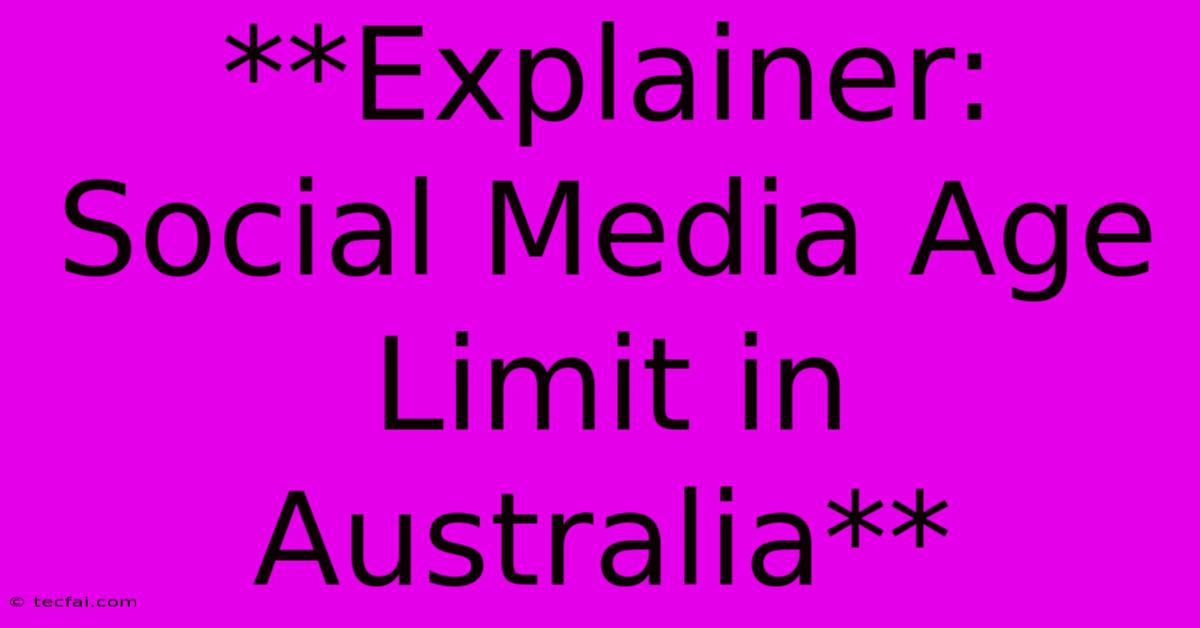**Explainer: Social Media Age Limit In Australia**

Discover more detailed and exciting information on our website. Click the link below to start your adventure: Visit Best Website tecfai.com. Don't miss out!
Table of Contents
Explainer: Social Media Age Limit in Australia
In the digital age, social media platforms have become an integral part of our lives. However, with the rise of online platforms, concerns about the safety and well-being of children have also escalated. This has led to discussions about establishing age limits for social media access, particularly in Australia.
This article will delve into the current landscape of social media age limits in Australia, examining the regulations in place, the rationale behind them, and the ongoing debate surrounding this complex issue.
Current Regulations: A Patchwork Approach
Australia currently lacks a unified national law dictating age limits for social media platforms. Instead, a patchwork of regulations exists, encompassing various laws and guidelines:
- The Australian Competition and Consumer Commission (ACCC): The ACCC sets guidelines for social media platforms, emphasizing the importance of age verification and data protection.
- The Australian Children's eSafety Commissioner: This independent body plays a crucial role in promoting online safety for children. They work with social media platforms to address concerns about online harms, including bullying, cyberbullying, and access to inappropriate content.
- Individual Platform Policies: Each social media platform sets its own age limits for account creation. For instance, Facebook and Instagram require users to be at least 13 years old, while TikTok mandates a minimum age of 16.
Why Age Limits? The Rationale
The rationale behind establishing age limits for social media access revolves around safeguarding children and adolescents from potential harms:
- Privacy and Data Protection: Children are particularly vulnerable to data breaches and privacy violations. Age limits help mitigate these risks by ensuring that platforms collect and use personal information in a responsible manner.
- Mental Health and Well-being: Excessive social media use has been linked to mental health issues like anxiety, depression, and body image concerns. By limiting access, particularly during crucial developmental stages, it's hoped that we can mitigate these negative effects.
- Cyberbullying and Online Predators: Children are more susceptible to online predators and cyberbullying. Age limits aim to create a safer online environment by limiting access to potentially harmful content and interactions.
- Cognitive Development: Children's brains are still developing, and exposure to excessive online content can impact cognitive functions, attention spans, and sleep patterns. Age limits can help regulate exposure to ensure healthy development.
Challenges and Debate
While the goal of safeguarding children is widely agreed upon, there are ongoing debates and challenges surrounding the implementation of age limits:
- Enforcement Challenges: Verifying the age of users online can be challenging. How do platforms ensure that users are accurately declaring their age?
- Privacy Concerns: Collecting personal information to verify age raises concerns about data privacy and potential misuse.
- Accessibility and Digital Divide: Age limits could disproportionately impact marginalized communities or those with limited access to technology.
- Effectiveness of Age Limits: The effectiveness of age limits in mitigating online harms is still under debate. Are they sufficient, or are more comprehensive measures needed?
The Future of Social Media Age Limits
The debate on social media age limits is likely to continue in Australia. As technology evolves, the need to balance children's online rights with their safety remains a complex and crucial issue. Further research, collaboration between governments, social media platforms, and educators is essential to find effective solutions and ensure a safer digital world for all.
Keywords:
- Social Media Age Limit
- Australia
- Age Verification
- Data Protection
- Online Safety
- Children's Well-being
- Mental Health
- Cyberbullying
- Digital Divide
- Australian Competition and Consumer Commission (ACCC)
- Australian Children's eSafety Commissioner
This article provides an overview of the social media age limit landscape in Australia, highlighting the regulations, rationale, challenges, and ongoing debate. It utilizes relevant keywords and explores the complexities of the issue, aiming to enhance its visibility and searchability.

Thank you for visiting our website wich cover about **Explainer: Social Media Age Limit In Australia**. We hope the information provided has been useful to you. Feel free to contact us if you have any questions or need further assistance. See you next time and dont miss to bookmark.
Featured Posts
-
Trump Win Fuels Bitcoin 78 000 Target In Sight
Nov 07, 2024
-
Eustace Praises Top Performance
Nov 07, 2024
-
West Indies 56 1 Live Score Updates England Vs Wi
Nov 07, 2024
-
7 11 Day Free Slurpees Catch The Changes
Nov 07, 2024
-
Great To Have Martin Back Mikels Quotes
Nov 07, 2024
